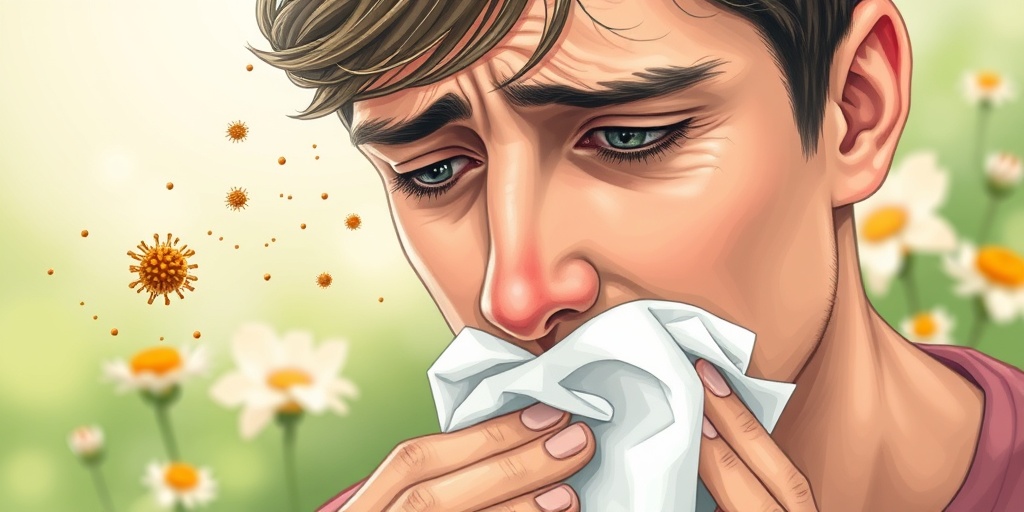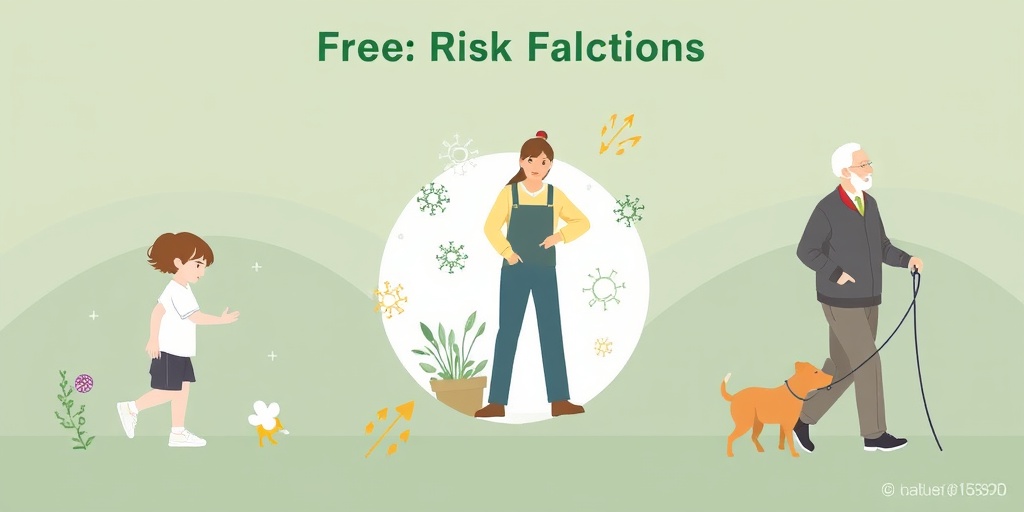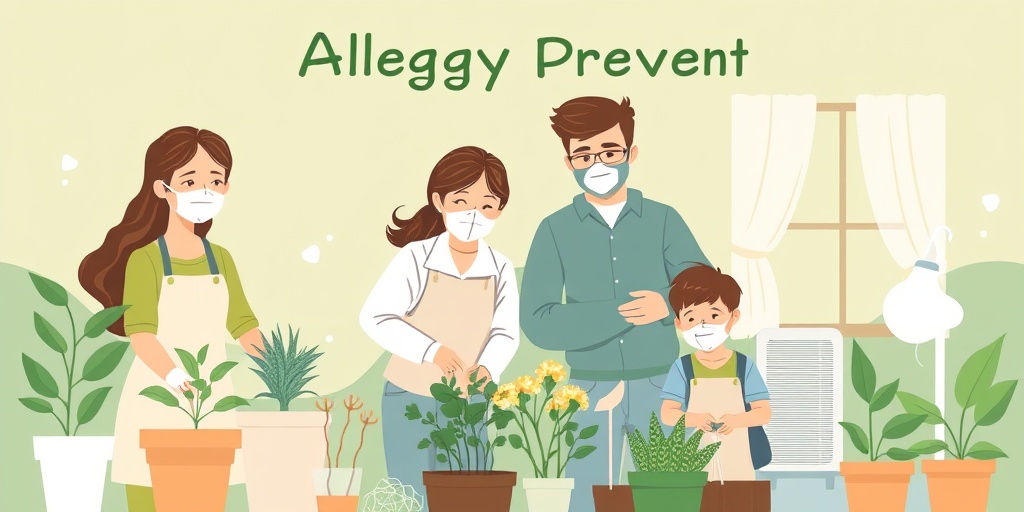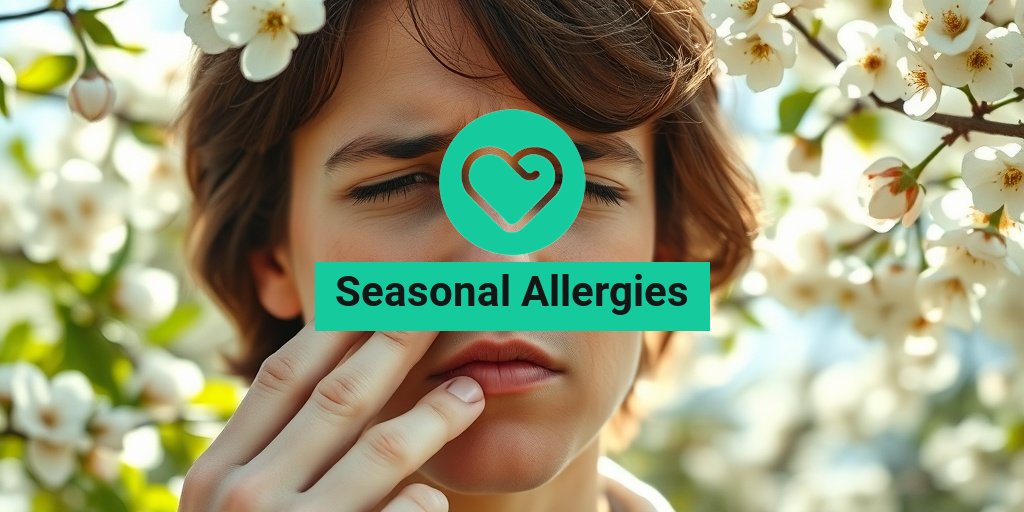What Are Seasonal Allergies?
Seasonal allergies, often referred to as hay fever or allergic rhinitis, are a common condition that affects millions of people worldwide. These allergies occur when the immune system overreacts to allergens present in the environment during specific seasons. The most common triggers include pollen from trees, grasses, and weeds, which can vary depending on the time of year and geographical location.
As the seasons change, so do the types of allergens in the air. For instance, spring often brings tree pollen, summer is typically associated with grass pollen, and fall is dominated by ragweed pollen. Understanding the timing and sources of these allergens can help individuals manage their symptoms more effectively.
How Do Seasonal Allergies Develop?
When a person with seasonal allergies comes into contact with these allergens, their immune system mistakenly identifies them as harmful invaders. This triggers the release of histamines and other chemicals, leading to the symptoms commonly associated with allergies. Factors such as genetics, environmental exposure, and even climate change can influence the severity and prevalence of seasonal allergies.
Who Is Affected by Seasonal Allergies?
Seasonal allergies can affect anyone, regardless of age or background. However, they are particularly common in children and young adults. Interestingly, some individuals may develop allergies later in life, even if they have never experienced symptoms before. If you suspect you or a loved one is suffering from seasonal allergies, it’s essential to consult a healthcare professional for proper diagnosis and management.
Seasonal Allergy Symptoms
Recognizing the symptoms of seasonal allergies is crucial for effective management. The symptoms can vary in intensity and may include:
- Runny or Stuffy Nose: Often accompanied by sneezing, this is one of the most common symptoms.
- Itchy Eyes, Nose, or Throat: Allergens can cause significant discomfort, leading to persistent itching.
- Coughing: This may occur due to postnasal drip, where mucus drips down the throat.
- Fatigue: Allergies can lead to tiredness, especially if symptoms disrupt sleep.
- Headaches: Sinus pressure from congestion can result in headaches.
Seasonal Allergies in Different Age Groups
Seasonal allergies can manifest differently across various age groups:
- In Toddlers: Symptoms may include irritability, runny nose, and difficulty sleeping. Parents should monitor their children closely and consult a pediatrician if symptoms persist.
- In Babies: Allergies can be tricky to diagnose in infants, but signs may include excessive fussiness and difficulty feeding. Always seek medical advice if you suspect allergies.
- In Dogs: Pets can also suffer from seasonal allergies, exhibiting symptoms like itching, sneezing, and watery eyes. If you notice these signs in your furry friend, consult a veterinarian.
When to Seek Medical Help
If you experience severe symptoms or if over-the-counter medications do not provide relief, it may be time to consult a healthcare professional. They can offer tailored advice and treatment options, including prescription medications or allergy testing.
For more information on managing seasonal allergies and finding evidence-based health answers, consider visiting Yesil Health AI. They provide valuable resources to help you navigate your health concerns effectively.
In conclusion, understanding seasonal allergies and their symptoms is the first step toward effective management. By being aware of the triggers and seeking appropriate treatment, you can enjoy the beauty of each season without the discomfort of allergies. 🌼🌿

Common Triggers of Seasonal Allergies
Seasonal allergies, often referred to as hay fever or allergic rhinitis, can significantly impact your quality of life. Understanding the common triggers is essential for managing symptoms effectively. Here are some of the most prevalent culprits:
Pollen
Pollen is one of the primary triggers for seasonal allergies. It is released by trees, grasses, and weeds during specific times of the year. The most common types of pollen include:
- Tree Pollen: Typically peaks in spring, with trees like oak, birch, and cedar being major offenders.
- Grass Pollen: Usually prevalent in late spring and early summer, with species such as Bermuda and Timothy grass.
- Weed Pollen: Common in late summer and fall, with ragweed being one of the most notorious sources.
Mold Spores
Mold spores can also trigger seasonal allergies, especially in damp environments. Mold thrives in warm, humid conditions, and its spores can become airborne, leading to allergic reactions. Common sources include:
- Outdoor Mold: Found in decaying leaves and compost piles, particularly in the fall.
- Indoor Mold: Can grow in bathrooms, kitchens, and basements, especially if there is water damage.
Dust Mites
While dust mites are not strictly seasonal, they can exacerbate allergy symptoms year-round. These microscopic creatures thrive in bedding, upholstery, and carpets, feeding on dead skin cells. Regular cleaning and using allergen-proof covers can help reduce exposure.
Pet Dander
For those with furry friends, pet dander can be a significant trigger. Proteins found in the skin flakes, urine, and saliva of pets can cause allergic reactions. If you are allergic to pets, consider keeping them out of your bedroom and using air purifiers to minimize exposure.
Risk Factors for Seasonal Allergies
Understanding the risk factors associated with seasonal allergies can help you take proactive measures to manage your symptoms. Here are some key factors to consider:
Genetics
If you have a family history of allergies, you may be more susceptible to developing seasonal allergies yourself. Genetics play a crucial role in determining your likelihood of experiencing allergic reactions.
Age
Seasonal allergies can develop at any age, but they often begin in childhood or early adulthood. Interestingly, some individuals may outgrow their allergies, while others may develop new sensitivities later in life.
Environmental Factors
Your living environment can significantly influence your risk of developing seasonal allergies. Factors include:
- Geographic Location: Certain areas have higher pollen counts, particularly during specific seasons.
- Climate: Warmer climates can lead to longer pollen seasons, increasing exposure.
- Air Quality: Poor air quality can exacerbate allergy symptoms and increase sensitivity.
Other Allergies
If you already have other allergies, such as food allergies or allergic asthma, you may be at a higher risk for developing seasonal allergies. The immune system’s heightened sensitivity can lead to a greater likelihood of reacting to pollen and other allergens.
Exposure to Irritants
Exposure to irritants like tobacco smoke, strong odors, and pollution can increase your risk of developing seasonal allergies. These irritants can inflame the nasal passages, making them more susceptible to allergens.
By understanding the common triggers and risk factors associated with seasonal allergies, you can take steps to minimize your exposure and manage your symptoms effectively. 🌼🌿

Diagnosing Seasonal Allergies
Seasonal allergies, often referred to as hay fever or allergic rhinitis, can significantly impact your quality of life. Understanding how these allergies are diagnosed is crucial for effective management. Here’s a closer look at the diagnostic process.
Recognizing Symptoms
The first step in diagnosing seasonal allergies is recognizing the symptoms. Common symptoms include:
- Runny or stuffy nose 🤧
- Itchy or watery eyes 👀
- Sneezing 🤧
- Coughing 😷
- Fatigue 😴
These symptoms typically occur during specific seasons when certain allergens, such as pollen from trees, grasses, or weeds, are prevalent. Keeping a symptom diary can help identify patterns and triggers.
Consulting a Healthcare Professional
If you suspect you have seasonal allergies, the next step is to consult a healthcare professional. They will conduct a thorough medical history and physical examination. Be prepared to discuss:
- Your symptoms and their duration
- Any family history of allergies
- Environmental factors that may contribute to your symptoms
Allergy Testing
To confirm a diagnosis, your doctor may recommend allergy testing. There are two primary types of tests:
- Skin Prick Test: Small amounts of allergens are introduced to your skin using a tiny prick. If you’re allergic, a small bump will appear.
- Blood Test: This test measures the level of specific antibodies (IgE) in your blood that react to allergens.
Both tests are effective, and your healthcare provider will determine which is best for you based on your symptoms and medical history.
Seasonal Allergy Treatments
Once diagnosed, managing seasonal allergies becomes the next priority. Fortunately, there are several effective treatments available to alleviate symptoms and improve your quality of life.
Over-the-Counter Medications
Many people find relief from seasonal allergies through over-the-counter (OTC) medications. Common options include:
- Antihistamines: These help reduce sneezing, itching, and runny nose. Popular choices include cetirizine (Zyrtec) and loratadine (Claritin).
- Decongestants: These can relieve nasal congestion. Pseudoephedrine (Sudafed) is a common example.
- Nasal Corticosteroids: These sprays, like fluticasone (Flonase), help reduce inflammation in the nasal passages.
Always consult with a healthcare professional before starting any new medication to ensure it’s appropriate for your situation.
Prescription Medications
If OTC options are insufficient, your doctor may prescribe stronger medications. These can include:
- Prescription Antihistamines: These may be more effective for severe symptoms.
- Leukotriene Receptor Antagonists: Medications like montelukast (Singulair) can help manage symptoms.
Allergy Shots (Immunotherapy)
For long-term relief, allergy shots may be recommended. This treatment involves regular injections of allergens over time, helping your body build tolerance. While this method can take several months to show results, it can provide lasting relief from seasonal allergies.
Natural Remedies
Some individuals prefer natural remedies to manage their seasonal allergies. Options include:
- Saline Nasal Rinses: These can help clear allergens from your nasal passages.
- Local Honey: Some believe that consuming local honey may help build immunity to local pollen.
- Herbal Supplements: Certain herbs, like butterbur, have shown promise in reducing allergy symptoms.
Always consult with a healthcare provider before trying new remedies, especially if you are on other medications.
Preventive Measures
In addition to treatments, taking preventive measures can help minimize exposure to allergens:
- Stay Indoors: During high pollen counts, limit outdoor activities.
- Keep Windows Closed: Use air conditioning to filter out pollen.
- Shower After Being Outdoors: This helps remove pollen from your skin and hair.
By understanding how to diagnose and treat seasonal allergies, you can take proactive steps to manage your symptoms and enjoy a more comfortable life. 🌼

Home Remedies for Seasonal Allergies
Seasonal allergies can be a real nuisance, causing discomfort and disrupting daily life. Fortunately, there are several home remedies that can help alleviate symptoms and make the allergy season more bearable. Here are some effective strategies you can try:
1. Saline Nasal Rinse
A saline nasal rinse can help clear allergens from your nasal passages. This simple solution involves mixing salt with warm water and using a neti pot or a nasal spray bottle to flush out irritants. Regular rinsing can reduce congestion and improve breathing.
2. Local Honey
Some people swear by consuming local honey as a way to combat seasonal allergies. The theory is that local honey contains small amounts of pollen, which may help your body build immunity over time. Try adding a spoonful to your tea or yogurt for a sweet treat! 🍯
3. Herbal Teas
Certain herbal teas, such as peppermint, ginger, and chamomile, can provide relief from allergy symptoms. These teas have natural anti-inflammatory properties that can soothe your throat and reduce congestion. Plus, they keep you hydrated! ☕
4. Apple Cider Vinegar
Apple cider vinegar is another popular remedy for seasonal allergies. It can help reduce mucus production and improve overall respiratory health. Mix one to two tablespoons of apple cider vinegar in a glass of water and drink it daily for best results.
5. Essential Oils
Essential oils like eucalyptus, lavender, and tea tree oil can be beneficial for allergy sufferers. You can use a diffuser to disperse these oils in your home or add a few drops to a warm bath for a relaxing experience. Just be sure to check for any allergies to the oils themselves before use! 🌿
6. Quercetin-Rich Foods
Quercetin is a natural antihistamine found in foods like onions, apples, and berries. Incorporating these foods into your diet may help reduce allergy symptoms. Try adding sliced apples to your breakfast or snacking on berries throughout the day for a tasty boost! 🍏🍓
7. Probiotics
Maintaining a healthy gut can have a positive impact on your immune system. Probiotics, found in yogurt and fermented foods, can help balance gut bacteria and may reduce the severity of allergic reactions. Consider adding a probiotic supplement or more fermented foods to your diet.
Preventing Seasonal Allergies
While home remedies can provide relief, prevention is key when it comes to managing seasonal allergies. Here are some effective strategies to help you avoid allergy triggers:
1. Monitor Pollen Counts
Stay informed about local pollen counts by checking weather apps or websites. On days when pollen levels are high, try to limit outdoor activities, especially in the morning when pollen is often at its peak.
2. Keep Windows Closed
During allergy season, keeping your windows closed can help prevent pollen from entering your home. Use air conditioning instead, and consider using HEPA filters to trap allergens indoors.
3. Shower After Outdoor Activities
After spending time outside, take a shower and change your clothes to remove any pollen that may have clung to you. This simple step can significantly reduce your exposure to allergens.
4. Use Allergy-Proof Bedding
Invest in allergy-proof covers for your pillows and mattresses. These covers can help keep dust mites and other allergens at bay, providing a more comfortable sleeping environment.
5. Regular Cleaning
Keep your home clean by regularly dusting and vacuuming. Use a vacuum cleaner equipped with a HEPA filter to effectively trap allergens. Don’t forget to wash your bedding and curtains frequently! 🧹
6. Avoid Outdoor Activities on Windy Days
Wind can stir up pollen and other allergens, making it a bad time for outdoor activities. If it’s windy, try to stay indoors as much as possible to minimize your exposure.
7. Consult with a Healthcare Professional
If your seasonal allergies are severe, consider consulting with a healthcare professional. They can provide personalized advice and may recommend medications or allergy shots to help manage your symptoms effectively.
By implementing these home remedies and preventive measures, you can take control of your seasonal allergies and enjoy a more comfortable life during allergy season! 🌼

Frequently Asked Questions about Seasonal Allergies
What are the common symptoms of seasonal allergies? 🤧
Seasonal allergies can cause a variety of symptoms, including:
- Runny or stuffy nose
- Itchy or watery eyes
- Sneezing
- Coughing
- Fatigue
How can I treat seasonal allergies effectively? 💊
Treatment options for seasonal allergies include:
- Over-the-counter antihistamines
- Decongestants
- Allergy shots (immunotherapy)
- Prescription medications
Are seasonal allergies common in children? 👶
Yes, seasonal allergies can affect toddlers and babies. Symptoms may vary, and it’s important to consult a pediatrician for appropriate treatment options.
Can seasonal allergies affect pets? 🐶
Absolutely! Dogs can also suffer from seasonal allergies, showing symptoms like itching, sneezing, and watery eyes. If you suspect your pet has allergies, consult a veterinarian.
What triggers seasonal allergies? 🌼
Common triggers for seasonal allergies include:
- Pollen from trees, grasses, and weeds
- Mold spores
- Dust mites
Is there a specific ICD-10 code for seasonal allergies? 📋
Yes, seasonal allergies are classified under specific ICD-10 codes, which healthcare providers use for diagnosis and billing purposes. It’s best to consult your healthcare provider for the exact code relevant to your condition.
How can I manage seasonal allergies in my home? 🏡
To manage seasonal allergies indoors, consider the following tips:
- Keep windows closed during high pollen seasons
- Use air purifiers
- Regularly clean and vacuum your home
When should I see a doctor for seasonal allergies? 🩺
If your symptoms are severe, persistent, or affecting your daily life, it’s advisable to consult a healthcare professional for further evaluation and treatment options.




